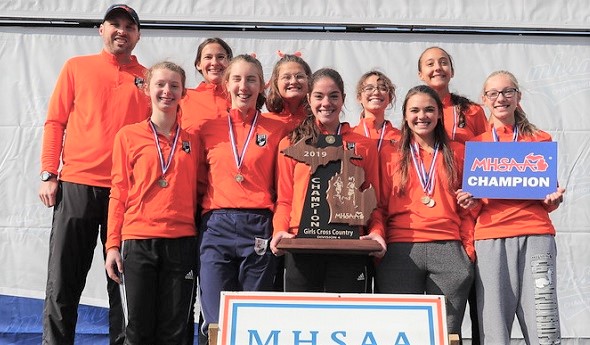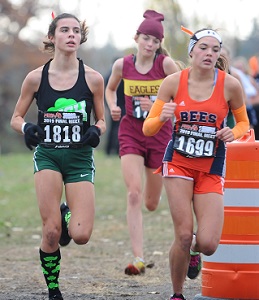
Bridgman Completes Climb to 1st Title
December 18, 2019
By Geoff Kimmerly
Second Half editor
Bridgman girls cross country coach Spencer Carr couldn’t recall his team having a bad meet this fall. And there were a couple of especially good showings that seemed to forecast the Bees’ historic season-ending finish.
 On Sept. 21, Bridgman traveled to New Prairie, Ind., and won the Varsity A race against schools twice its enrollment of roughly 250 students. Two weeks later, the Bees finished second in the Division 4 race at the prestigious Portage Invitational, just a point off the lead.
On Sept. 21, Bridgman traveled to New Prairie, Ind., and won the Varsity A race against schools twice its enrollment of roughly 250 students. Two weeks later, the Bees finished second in the Division 4 race at the prestigious Portage Invitational, just a point off the lead.
And in both races, their top runner placed sixth individually, another coincidental sign of how the team would win its first MHSAA Finals championship in girls cross country Nov. 6 at Michigan International Speedway.
With junior Karsyn Stewart leading the way with a sixth-place individual finish, Bridgman scored 132 points to outpace four-time reigning champion Mount Pleasant Sacred Heart and lock up the title – and the honor as MHSAA/Applebee’s “Team of the Month” for November.
“Coming into the season, I had hopes of a top-10 finish, maybe top five if everything progressed well,” Carr said. “I never really looked at who was a contender at the top of Division 4 until we started to place high at some big meets. We knew Mount Pleasant Sacred Heart was good and had won state the year before, but it wasn't until part way through the year that I noticed they had won it the last four years.
“We talked about the challenge of beating a team like that, one with experience that always seemed to run well in the big meets. We knew it was going to be very tough to beat them because they knew how to win in the big meets, and we were pretty new to being towards the top. The girls realized early on that they could only control how they ran. If they did everything they could do to run their best race, then that would put us in a pretty good position.”
That mindset paid off well. At the Regional, Bridgman scored just 35 points placing four among the top 10 and five among the top 13. At the Final, Stewart was followed by sophomore Arie Hackett in 11th, freshman Summer Fast in 39th, sophomore Jane Kaspar in 68th and senior Mikaela Owen in 81st.
Stewart had led the way as well in 2018, when Bridgman finished 15th as a team and she finished 24th individually. She was 35th as a freshman in 2017 as the team also finished 15th – setting an early foundation for this rise to the top.
Before this fall, the Bees’ best Finals finish was fifth in Class D in 1985. They didn’t qualify as a team for the championship races again until 2015, when they finished 24th in Division 3.
 Longtime coach John Wismer had built a strong boys program (Division 4 runner-up finishes in 2009 and 2010) and helped put the girls team in position before retiring after the 2016 season. Kurt Hanke led the Bees in taking the next steps in 2017 before Carr – previously the boys cross country coach at Hartford from 2010-16 – took over both Bridgman programs the following summer. He credited both predecessors for helping the Bees build toward their first title.
Longtime coach John Wismer had built a strong boys program (Division 4 runner-up finishes in 2009 and 2010) and helped put the girls team in position before retiring after the 2016 season. Kurt Hanke led the Bees in taking the next steps in 2017 before Carr – previously the boys cross country coach at Hartford from 2010-16 – took over both Bridgman programs the following summer. He credited both predecessors for helping the Bees build toward their first title.
But this fall did have some early unpredictability. Bridgman had graduated three of its top five from the 2018 Finals lineup, including its second and third-highest placers. Carr knew he had Stewart and lone senior Owen, but other pieces had to fall into place as well.
Carr knew Kaspar had lots of potential, and that Fast had been successful in middle school. Bridgman got a major boost from Hackett, also a basketball and softball player who hadn’t run as a freshman.
They came together to win all of their races this fall but two – at Portage and against a field of much larger schools at the Kalamazoo Christian Invitational, where the Bees finished second to Grand Rapids South Christian (which went on to place 19th at the Division 2 Final). Bridgman also won its Berrien-Cass-St. Joseph Conference title and posted a perfect score of 15 at the River Valley Mustang Invitational.
Bridgman expects to return six of its top seven runners next year; sophomore Grace Fenech and junior Alexa Ackerman followed Owen in the Finals lineup. But Sacred Heart should be back in Division 4 contention, along with third-place finisher Kalamazoo Christian – which edged the Bees at Portage. And there always could be another Bridgman-type team preparing to make a big jump – so the Bees know what they face to stay on top.
“We lost a bunch of seniors last year who really were the start of really getting the girls program going, so I wasn't really sure how good we could be,” Carr said. “I knew we had Karsyn Stewart, who was all-state the year before, and Mikaela Owen, our only senior and a great leader, but I wasn't too sure after that.
“They all came together over the summer and put in the work, and it translated into a great season.”
Past Teams of the Month, 2019-20
October: Allegan boys tennis - Report
September: Ishpeming Westwood girls tennis - Report
PHOTOS: (Top) Bridgman’s girls cross country team poses with its first MHSAA Finals championship trophy during the awards ceremony at Michigan International Speedway. (Middle) Arie Hackett (1699) works to keep a step ahead of Sacred Heart’s Olivia Ervin. (Photos by Dave McCauley/RunMichigan.com.)

MHSAA Vault: MIS Rose to Challenges to Host 2020 LP Finals
By
Rob Kaminski
MHSAA benchmarks editor
November 12, 2021
The “MHSAA Vault” features stories from past publications and other documents in the MHSAA Library. This issue takes a look at the MHSAA Cross Country Finals at Michigan International Speedway, which celebrated 25 years in 2020 – although it was an event that nearly didn’t happen last fall …
In 1996, the MHSAA and Michigan International Speedway began a partnership the changed the course of the Lower Peninsula Cross Country Finals – quite literally.
The land in and around the track at Brooklyn would host the Finals for all classes of runners in one place on one day, an annual festival of nearly 2,000 runners competing for the MHSAA’s top honors.
Even skeptics – and there were several among running purists who thought the course was too flat, for example – can’t deny the results.
Finals attendance nearly doubled in that first year, and crowds in excess of 10,000 have enjoyed a day of racing several times, including a record 12,153 in 2011.
Enthusiastic crowds were the norm in recent years, with 11,232 in 2017, and nearly 11,000 in 2018 (10,989) and 2019 (10,873).
In fact, attendance failed to reach at least 8,000 only twice since the move to MIS.
Of course, last year was an exception, when attendance was limited to 1,000 spectators per session due to the COVID-19 Pandemic. Fans also were restricted to the grandstands rather than following the action throughout locations on the course.
To reduce the number of runners in each race, the event was spread over two days, with each Division being run in two separate “sections” with times then combined at the end to determine team and individual champions.
While not ideal, the end result was another year of fantastic efforts at MIS – both from student-athletes and those behind the scenes.
“Even at the last hour, less than a week ahead of the Finals, we were closer to not having the Finals than we were to having them,” said MHSAA Assistant Director Cody Inglis, who coordinates the cross country postseason. “Rumors and challenges of mandated shutdowns, testing and other requirements were being discussed and caused a lot of unknowns. Even at the Regional level, we had schools, Regional courses and hosts shutting down their facilities; we had to relocate four Regionals 48 hours prior to race times. That scenario just could not happen at the Finals level where far more runners and much more travel would be involved.”
Among the many last-minute hurdles was the edict from NASCAR – which owns MIS – that all persons on site be temperature checked upon entry. That meant securing thermometers that were easy to operate in short order, along with personnel necessary to conduct the readings.
The attendance limitations certainly helped to implement the temperature screening, but brought their own issues.
“Limiting spectators was not a popular decision, but it really was the only way to have a race,” Inglis said. “We were taking direction and working with policies and protocols from the MDHHS, the Governor’s office, Lenawee County Health Department, MIS and NASCAR.”
Part of the solution was to utilize the grandstands as a “barrier” between participants and spectators. The reduced number of fans were dispersed over thousands of seats while still allowing them the chance to watch their student-athletes compete.
“It wasn’t the same, it wasn’t easy or perfect, but it was what we had to do to have a race,” Inglis said. “Separating the Finals into two days and different sections also allowed us to spread out the event and limit the number of people on site at any one time. This was a key part of the plan and worked well even though it separated races within a Division.”
The MHSAA, MIS and the cross country community never lost focus of the main goal: a culmination of the season for the student-athletes, who deserved something last year more than ever. And, more than ever, MIS once again displayed its advantage as a venue that could adapt to the fluid nature of the times to pull off the event.
“There were some thoughts of using four different sites, but as we learned during the Regionals, the climate of things was so tenuous from one area of the state to another that we couldn’t be 100-percent certain that there wouldn’t again be last-minute cancelations,” Inglis said. “MIS was wonderful to work and collaborate with, and was the best option to get it done. It was never mentioned once publicly about the possibility of not having the Finals – only how we could best do it under uncharted conditions.”
The moving parts and ever-changing scenarios created more complexity than ever in finalizing a season, but every decision was made with the complete desire to conduct the Finals as close to normal as possible.
“I firmly believe that a finish to the season, no matter the differences in race formatting and fan experience, was something everyone would have taken when the season began in August,” Inglis said.
Indeed, the finish line in Year 25 at MIS might have been the most gratifying of them all.

